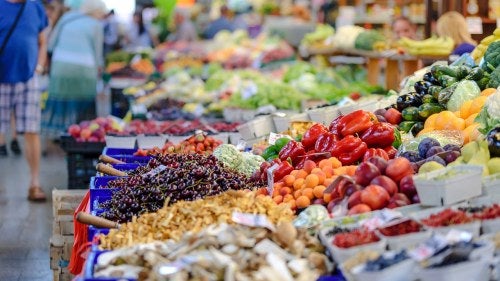Calories Alone Will Not Feed the World

The world needs a healthier food environment that is easier for everyday people to navigate in order to achieve nutrition security.
Just this month, the Food and Agriculture Organization (FAO) released its latest report on The State of Food Security and Nutrition in the World. Given the report’s sobering findings, mainly that the world has seen little to no progress in efforts to end hunger and malnutrition over the past year, we at the Chicago Council on Global Affairs have decided to revisit the topic of nutrition security. Even though the global food system produces more than enough food to feed every person on Earth—around 2,750 calories per person per day—many people around the world still go to bed hungry. Despite extensive and long-lasting efforts to promote food security, it’s estimated that between 691 and 783 million people in the world faced hunger in 2022.1
However, these statistics do not tell the full story of food insecurity, as they overlook the even more widespread issue of malnutrition. According to the World Food Programme, it affects one in three people around the world.2
We typically think about hunger in terms of quantity—whether people have enough food to meet their daily caloric needs. Even so, it is not only possible, but common, for individuals to eat enough calories and still be undernourished. Malnutrition happens when diets are unbalanced, either by consuming too little or too much of certain nutrients, and can take the form of stunting, wasting, anemia, obesity, and diet-related diseases. As a result of malnutrition, 22.3 percent of children under the age of five have stunted growth, 29.9 percent of women of reproductive age are anemic,3 462 million adults are underweight, and another 1.9 billion are obese.4
Malnutrition affects people in every demographic, at every income level, and in every country. Despite the many world-changing innovations that have substantially increased the world’s food supply, nutrition insecurity remains widespread, and certain forms of it are even on the rise. In many cases, the roots of nutrition insecurity stem from the very efforts meant to end global hunger.
The Mid-Century New Food Regime
Hunger and starvation are not new fears. For centuries, prominent figures have been sounding the alarm on population growth, claiming that eventually the Earth will run out of natural resources and lead to widespread famine. So far, the solution has been technology.
In the years after World War II, the United States and Europe implemented policy frameworks to combat a looming European hunger crisis. These included subsidies and food aid programs that encouraged farmers to produce the largest yields they could, without regard for market indicators.5 Agriculture became so productive during this period that the United States was able to hand out large amounts of excess grain to other countries through new foreign food aid programs. During the same period, the Soviet Union and communist allies shifted towards industrial models of agriculture to ensure large quantities of tradeable commodities.
This was followed by the Green Revolution, where a series of agricultural innovations tripled cereal crop production while only using 30 percent more land.6 Despite its massive successes, the benefits of the Green Revolution were not equally spread across all countries or income levels. Also, since innovation was so targeted to specific staple crops, it ended up replacing nutrient dense traditional crops with wide plots of less genetically diverse grains.
The result of this new food regime was an overabundance of cheap grains and processed foods, while micronutrient-dense fruits, vegetables, and legumes became increasingly inaccessible.
Malnutrition is the World’s Greatest Killer
Many people simply cannot access a healthy diet. Even in parts of the world where food is plentiful, nutritious foods such as fruits and vegetables are outnumbered by cheaper, more readily available processed goods. This feeds into one of the most common forms of malnutrition: obesity.
As contradictory as it may sound, overnutrition and undernutrition stem from the same roots. Obesity is the result of overconsumption of macronutrients and “empty calories” and underconsumption of micronutrients such as vitamins and minerals. According to the FAO, global adult obesity rates nearly doubled from 8.7 percent in 2000 to 13.1 percent in 2016.iii Alongside this came a rise in related illnesses—for example, one study found that the global rate of diabetes increased by 45 percent between 1990 and 2013 when adjusted for age.7
Popular perception often wrongly and cruelly mocks obesity as a personal failing. The truth, however, is that this trend is deeply entrenched in the structure of the global food system.
One study compared global agricultural production by food group to the diet recommended by the Harvard Healthy Eating Plate.8 They found that, per person, the world’s food system produces four more servings of grains, three more servings of fat, and four more servings of sugar than required for a healthy diet. In contrast, the food system also produces 10 fewer servings of fruits and vegetables and two fewer servings of protein than needed to meet the nutritional needs of every person on Earth. Calories aside, there simply is not enough healthy food to go around.
This issue will not be solved by rising incomes, as a report by the Global Panel on Agriculture and Food Systems for Nutrition points out.9 Even as agricultural productivity rises, the intake of foods that undermine diet quality increases even faster, while nutritiously dense foods remain relatively unobtainable. Rather than eliminating malnutrition, rising incomes simply swap one form of it for another.
When all its forms are combined, malnutrition represents the number one contributor to global disease. Undernutrition causes as much as 12 percent of total deaths worldwide, including 45 percent of deaths for children under five years old. Obesity is also a precursor to many chronic illnesses, including cardiovascular diseases, diabetes, and certain cancers, which make up the leading causes of death in high-income countries. In 2017, adding up these factors, Global Burden of Disease study found that suboptimal diets caused more deaths worldwide than any other risk, including tobacco smoke.10
A New Kind of Green Revolution
We will need more food as the population grows. However, the Earth’s resources are being stretched to their limits, and so much of the food we already produce does not reach the people who need it most. Simply expanding production, without changing the current model, will not be enough to solve hunger and malnutrition. This challenge requires a new kind of Green Revolution—one that looks beyond caloric availability and addresses the overlooked matter of nutrition security.
The global food system drastically needs social innovation and policy frameworks to facilitate more equitable distribution of the food we do have, and incentivize production of the healthy foods we lack. Most importantly, more focus and attention need to be given to the kinds and ways that food is produced rather than the sheer quantity of cheap and calorically dense staples. After all, plant-based diets are not only healthier but will go a long way to reducing the global carbon footprint, freshwater use, and nitrogen pollution.
To combat obesity in particular, this must include developing a healthier food environment that is easier for everyday people to navigate. The Chicago Council on Global Affairs is partnering with Texas A&M’s Institute for Advancing Health Through Agriculture to lay the groundwork for this end. This includes spearheading a study to advance the concept of responsive agriculture, which aims to advance health and nutrition by cultivating new agricultural systems and food environments that can reduce the prevalence of diet-related chronic diseases. This study will serve as an important first step in addressing this global issue, starting with the United States. The road to zero hunger and nutrition security is long one, with many challenges along the way, but the potential benefits are well worth the fight.
- 1
FAO, IFAD, UNICEF, WFP, and WHO. “The State of Food Security and Nutrition in the World.” The State of Food Security and Nutrition in the World 2023 (SOFI). Urbanization, agrifood systems transformation and healthy diets across the rural–urban continuum |Policy Support and Governance| Food and Agriculture Organization of the United Nations , 2023.
- 2
“Nutrition: World Food Programme.” UN World Food Programme. Accessed July 13, 2023.
- 3
FAO, IFAD, UNICEF, WFP, and WHO. “The State of Food Security and Nutrition in the World 2022: Repurposing Food and Agricultural Policies to Make Healthy Diets More Affordable.” fao.org, 2022.
- 4
“Fact Sheets - Malnutrition.” World Health Organization, June 9, 2021.
- 5
Evans, David, Hugh Campbell, and Anne Murcott. “A Brief Prehistory of Food Waste and the Social Sciences - Sites.Tufts.Edu.” The Sociological Review, 2013.
- 6
Pingali, Prabhu. “Green Revolution: Impacts, Limits, and the Path Ahead.” PNAS, July 31, 2012.
- 7
Vos, T, FJ Charlson, L Degenhardt, RJ Hay, GA Mensah, CJL Murray, HA Whiteford, et al. “Global, Regional, and National Incidence, Prevalence, and Years Lived with Disability for 301 Acute and Chronic Diseases and Injuries in 188 Countries, 1990–2013: A Systematic Analysis for the Global Burden of Disease Study 2013.” The Lancet, June 7, 2015.
- 8
Kc, Krishna Bahadur, Goretty M Dias, Anastasia Veeramani, Clarence J Swanton, David Fraser, Dirk Steinke, Elizabeth Lee, et al. “When Too Much Isn’t Enough: Does Current Food Production Meet Global Nutritional Needs?” PloS one, October 23, 2018.
- 9
Global Panel on Agriculture and Food Systems for Nutrition. Food systems and diets: Facing the challenges of the 21st century, 2016.
- 10
GBD 2017 Diet Collaborators. “Health Effects of Dietary Risks in 195 Countries, 1990–2017: A Systematic Analysis for the Global Burden of Disease Study 2017.” The Lancet, April 3, 2019.

